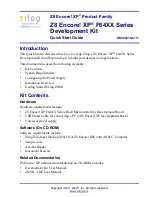QUEUED SERIAL MODULE
M68HC16 Z SERIES
9-16
USER’S MANUAL
Normally, the SPI bus performs synchronous bidirectional transfers. The serial clock
on the SPI bus master supplies the clock signal SCK to time the transfer of data. Four
possible combinations of clock phase and polarity can be specified by the CPHA and
CPOL bits in SPCR0.
Data is transferred with the most significant bit first. The number of bits transferred per
command defaults to eight, but can be set to any value from eight to sixteen bits inclu-
sive by writing a value into the BITS[3:0] field in SPCR0 and setting BITSE in the com-
mand RAM.
Typically, SPI bus outputs are not open-drain unless multiple SPI masters are in the
system. If needed, the WOMQ bit in SPCR0 can be set to provide wired-OR, open-
drain outputs. An external pull-up resistor should be used on each output line. WOMQ
affects all QSPI pins regardless of whether they are assigned to the QSPI or used as
general-purpose I/O.
9.3.5.1 Master Mode
Setting the MSTR bit in SPCR0 selects master mode operation. In master mode, the
QSPI can initiate serial transfers, but cannot respond to externally initiated transfers.
When the slave select input of a device configured for master mode is asserted, a
mode fault occurs.
Before QSPI operation begins, QSM register PQSPAR must be written to assign the
necessary pins to the QSPI. The pins necessary for master mode operation are MISO,
MOSI, SCK, and one or more of the chip-select pins. MISO is used for serial data input
in master mode, and MOSI is used for serial data output. Either or both may be nec-
essary, depending on the particular application. SCK is the serial clock output in mas-
ter mode and must be assigned to the QSPI for proper operation.
The PORTQS data register must next be written with values that make the PQS2/SCK
and PQS[6:3]/PCS[3:0] outputs inactive when the QSPI completes a series of trans-
fers. Pins allocated to the QSPI by PQSPAR are controlled by PORTQS when the
QSPI is inactive. PORTQS I/O pins driven to states opposite those of the inactive
QSPI signals can generate glitches that momentarily enable or partially clock a slave
device.
For example, if a slave device operates with an inactive SCK state of logic one (CPOL
= 1) and uses active low peripheral chip-select PCS0, the PQS[3:2] bits in PORTQS
must be set to %11. If PQS[3:2] = %00, falling edges will appear on PQS2/SCK and
PQS3/PCS0 as the QSPI relinquishes control of these pins and PORTQS drives them
to logic zero from the inactive SCK and PCS0 states of logic one.
Before master mode operation is initiated, QSM register DDRQS is written last to di-
rect the data flow on the QSPI pins used. Configure the SCK, MOSI and appropriate
chip-select pins PCS[3:0] as outputs. The MISO pin must be configured as an input.
After pins are assigned and configured, write appropriate data to the command queue.
If data is to be transmitted, write the data to transmit RAM. Initialize the queue pointers
as appropriate.
F
re
e
sc
a
le
S
e
m
ic
o
n
d
u
c
to
r,
I
Freescale Semiconductor, Inc.
For More Information On This Product,
Go to: www.freescale.com
n
c
.
..

















